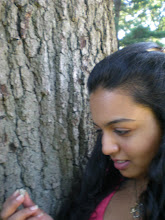The dots really intrigue me. On one hand, they seem like such a waste of space. On the other, plenty of poets use blank space, so maybe Minnis isn't stretching it too far. I wondered why Minnis chooses to use all the dots instead of just blank space like most poets would. I think that she is acknowledging the sort of 'heartbeat' I can feel in the poetry. The poem is still very much alive in those spaces. The silence is not really silent.
One of the poems that really had this effect on me was "Pitcher". The images are so clear, I can almost feel the water splashing over me, soaking my shirt, the pitcher clanging on the ground as it bounces away.
I believe that all the dots give us time to process what Minnis is writing. And the dots as opposed to the spaces feels like she is telling us, 'no, this is not a moment just to breathe, this is a moment to really consider the image I am painting for you'. For example, in "Tiger", pg. 45: After "beautiful, unbroken vase" she gives us time to really see that vase, feel the clay curves ourselves, before moving on to the next thing. A few lines down, after another longer string of dots, she says "expansiveness", like a comment on what just happened in the poem. On the other hand, she uses less dots between words on the previous page when she says, "how I want to replicate...... them or re-create their arcs........ or put them in a spotlight...... against a black backdrop" because they are images that really fit together and need to be considered more closely as parts of one idea.
Another tool that stood out to me in Minnis's work was the use of color, particularly red. It reminded me of Greenfield's tree-tool. The set of poems in Zirconia made me think of modern paintings such as this one: http://bw-inc.deviantart.com/art/BLACK-WHITE-RED-12895843
The picture is mainly black and white, but there is some red, and the red that is there really pops out at you. Minnis has repeated references to blood and redness in general. One of the poems in the book is even called "Maroon" and another is "Cherry". I would like to explore this motif further. Red is known to be the first color the eye picks up on in a scene and is a color associated with drama and shocking things in general. I wonder if this is why Minnis uses the color so much or if it is because of some childhood trauma associated with blood that she has had to deal with.


Shachi-
ReplyDeleteI love the way you think about the poetry in this book- as a heartbeat, the heart pulsating with each word or phrase in the book. Just as each heartbeat is important, and even one skipped beat is rather jarring for a person, I think that Minnis really tried to emphasize the importance of each word and phrase that she used. Even when the heart isn't beating, it is still doing work... With that said, one could say that it would be a waste to leave the rest of the page blank instead of using a continuation of dots; a blank space might imply that nothing was going on, that the space should be ignored. This is obviously not the case. If the space weren't important to the poem in some way, it wouldn't exist. I also noticed the that Minnis used a lot of shades of red in her poetry. Red is a very bold color, it stands out more than most other colors because it is such a vibrant hue. I think that Minnis' use of the color red relates to your mention of heartbeats. It would be appropriate for her to mention blood and red throughout the poem, much like a person has blood pumping throughout the body, the book is full of life in the form of vivid imagery and important words.
Shachi-
ReplyDeleteWhat you have here is a great account of Chelsey Minnis' book, Zirconia. I totally agree with you; the ellipses in this poem sounds like a heartbeat. The ellipses space out the poems so that we can imagine what is being said and what context it should be considered in. Minnis' technique was very intriguing and although there were so many dots, it definitely forced the audience to become active listeners and use their imagination. Another thing I commend you for is pointing out the significance the color red had in this book as did the trees in Greenfield's book.I, too, am confused as to what made Minnis focus so much on this color. However, it is very clear that the repeated direct and indirect references of the color red was done intentionally; and therefore, there is extreme significance behind this technique.